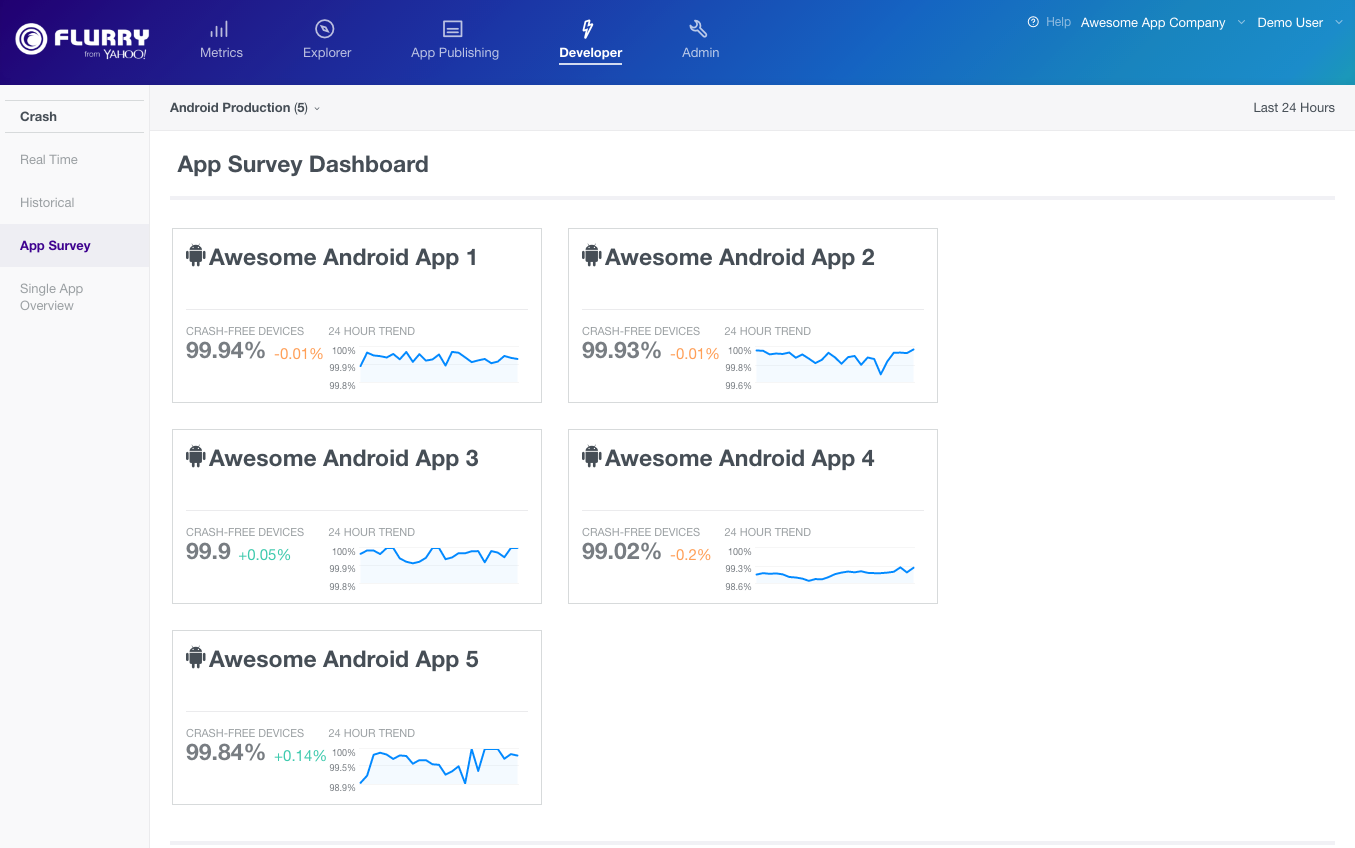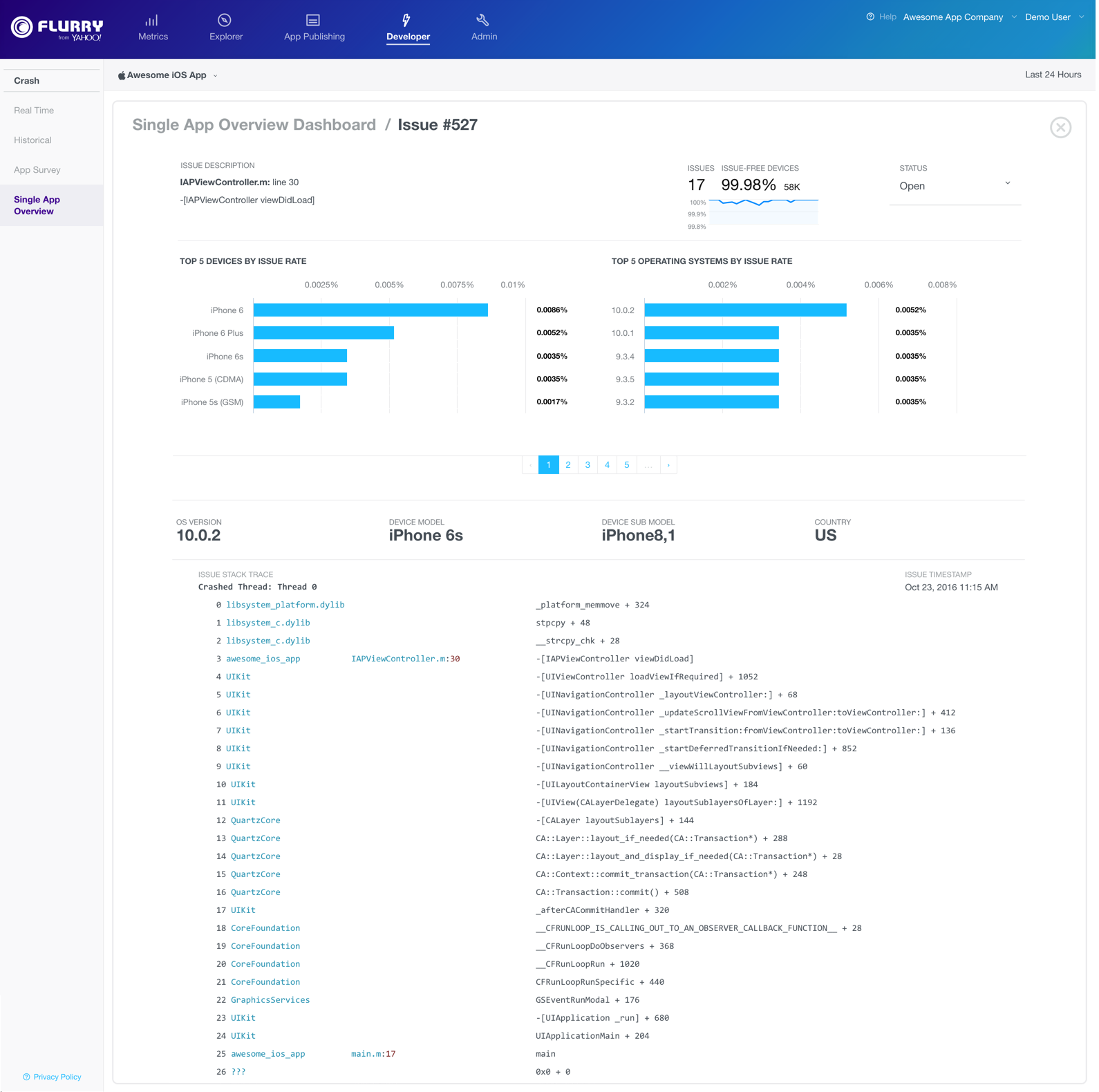Crash Uploaded to Developers
Crash Analytics¶
Crash Analytics 2.0 in Flurry gives y'all,in existent time, information about crashes, exceptions and errors in your app. This allows you make up one's mind the root crusade of whatsoever issue quickly, continue your app running well and the users of your app happy.
With Flurry Crash Analytics ii.0, you can :
-
understand how many devices and sessions have been affected past crashes, Caught Exceptions or logged errors in the past minutes and hours
-
compare the health of apps over the last yr
-
survey the health of collections of apps over the last 24 hours
-
review the collection of issues affecting a given app to find the well-nigh user-impacting
-
investigate the details of instances of a given issue including device details and symbolicated stack traces
-
automatically upload dSYM files from xCode using a build stage script
Issue Types¶
Flurry Crash Analytics provides insight on more than just crashes by including Defenseless Exceptions and Logged Errors likewise. These 3 types of problems are defined below:
-
Crash - An uncaught exception that occurred during the operation of the app that resulted in the app terminating abnormally.
-
Caught Exception - An exception that occurred during the operating of the app that was handled by an fault handler and reported using a method in the Flurry SDK.
-
Logged Error - An error experienced by the code of your app that your code logged using a method in the Flurry SDK. As at that place was no code execution exception in a Logged Fault, at that place is no stack trace provided.
For details on how to musical instrument each of these effect types, run across the Instrumentation section below.
Real Fourth dimension Dashboard¶
Similar to the Real Time dashboard located in the Metrics section of Flurry, the Real Fourth dimension dashboard in Crash Analytics displays data as it comes in to Flurry from your app. In that location are ii time periods that are displayed:
-
Minute by infinitesimal for last ii hours
-
Hour by hour for last 24 hours
For each of these fourth dimension periods, there are three charts showing the post-obit metrics:
-
Device Touch on Rate - The number of devices that experienced an consequence in the the period divided by the number of devices that were agile in the period.
-
Session Impact Rate - The number of sessions that experienced an outcome in the the period divided by the number of sessions that occurred in the menstruation.
-
Result Occurrence Count - The number of problems that occurred in the period.
Filtering¶
Y'all can filter the data on this dashboard by whatsoever of the following attributes:
-
App Version
-
Country
-
Device Model
-
Device Model Code (e.g. iPhone 6,1)
-
Outcome Type
-
OS Version
-
Flurry SDK Version
Historical Dashboard¶
The Historical Dashboard displays the same metrics equally the Real Time dashboard, with two main differences.
The Historical dashboard:
-
provides access to a yr of data as opposed to the 1 twenty-four hours on the Real Time dashboard.
-
supports a subset of the filters that are supported for Existent Time
-
App Version
-
Land
-
Outcome Type
-
OS Version
-
App Survey¶
The App Survey provides a quick look at the performance of collections of apps. The apps displayed here are determined by the selected App Grouping. Flurry provides various default App Groups such as iOS Apps and Android Apps, but y'all can create your own App Groups for a customized look in the App Survey or other app-driven dashboards throughout Flurry.

Single App Overview¶
The Single App Overview, every bit it'south proper name implies, provides an overview of the issues affecting a single app. The page provides a list of all the bug that have occurred in the app and metrics that breakdown the types of these problems between Crashes, Caught Exceptions and Logged Errors.
Metrics¶
The metrics provided on the Single App Overview provide both an view into the overall health of the app likewise equally how the touch breaks down by Consequence Type.

The metrics are defined every bit follows:
-
Issue Free Devices - the percentage of devices active during the period that did not experience any issue.
-
Total Issues - the number of problems during the menses
-
Crashes - the number of bug of type Crash during the catamenia.
-
Crash-Free Devices - the percentage of devices that did non feel a crash during the period. The small-scale number to the right of the percent is the absolute number of these devices.
-
Exceptions - the number of bug of type Handled Exception during the period.
-
Exception-Free Devices - the percentage of devices that did non experience a Handled Exception during the period. The minor number to the right of the per centum is the absolute number of these devices.
-
Errors - the number of bug of blazon Logged Errors during the flow.
-
Error-Free Devices - the percentage of devices that did non experience a Logged Error during the period. The small number to the right of the percentage is the absolute number of these devices.
Missing dSYMs / Mapping Files¶
Flurry Crash Analytics supports the automatic upload of dSYMs for iOS and ProGuard Mapping files. When processing the incoming information, if Flurry finds that the correct files are non available for re-symbolicating the Crash or Handled Exception, a banner will appear that states files are missing.

Expanding this banner presents a table indicating the versions for which issues be that cannot be symbolicated, the number of these and their impact on users. Clicking on a row of this table allows you to browse the non-symbolicated stack traces and understand which files are required for symbolication.
Issues¶
The bug table presents the collection of all the unique problems that have occurred in the menstruum that could exist properly symbolicated. Uniqueness is adamant by fingerprinting the stack trace for issues that of type Crash or Handled Exception and by the name provided for Logged Errors.
| Column | Description |
|---|---|
| Status | Displays the current status of the detail. The possible values for Condition are Open and Resolved. The status can be changed on the item view for an issue. |
| Outcome Number | A unique number given to each issue as it is identified equally being unique. |
| Issue Description | For Crashs and Defenseless Exceptions, this typically includes the module, function and line number where the issue occurred. For Logged Errors, this is the name and description provided to the logging method in the SDK. |
| Issue Type | Identifies the issue every bit a Crash, Handled Exception or Logged Mistake. |
| First Seen Version | The first version on which the outcome was encountered. |
| Beginning Seen Engagement | The kickoff date/time the issue was encountered. |
| Terminal Seen Version | The latest version on which the issue was encountered. |
| Concluding Seen Date | The latest date/fourth dimension the result was encountered. |
| Occurrences | How many times this effect has occurred in the time menses. |
| Issue-Gratuitous Device Percentage | The per centum of devices active during the period that did not run into the outcome. |
Upshot Details¶
When you click on an item in the Issues table described in a higher place, the Issue Details page appears. This folio provides you with information related to the specific issue such as:
-
Occurrence and Touch on metrics
-
Device and OS Version breakdowns
-
Specific instances of the issue including information nigh the device and the actual stack trace
-
The current state of the issue, Open or Resolved

Browsing Instances¶
You tin can browse the provided instances of the issue using the control above the instance detail header. Clicking straight on one of the numbers will bring up that instance of the issue. Clicking on the arrows will provide access to boosted instances.

Resolving an Issue¶
In the upper right section of the page, there is a control that allows you to change the status of the displayed outcome. Past default, Bug have the condition Open up. To change an Upshot to Resolved, simply select Resolved from the dropdown. The alter is recorded immediately.

iOS Symbolication¶
For iOS, in that location are 2 sources for the dSYM files that are needed to support the symbolication of stack traces for crashes and Caught Exceptions. Flurry has dissimilar processes depending on whether or not you enable bitcode for your app. If yous would like to sympathise more nigh these dDYM files, you can read Apple tree's documentation hither.
xCode dSYMs¶
When you lot build your app in xCode, information technology produces dSYMs specific for that build. To enable easy upload of these files, Flurry Crash Analytics 2.0 has a script that you implement in a Build Phase in xCode which will upload the files when you execute a build. Yous tin can download the script and instructions for implementation from Flurry's Github.
bitcode dSYMs¶
In today's xCode, bitcode is enabled past default. With bitcode enabled, the debug symbols (contained within dSYM files) needed past Flurry to symbolicate your crashes will non exist stored on your mac, simply instead on Apple'due south servers. These dSYMs must be explicitly downloaded past you lot from Apple either through iTunes connect or xCode. You can read instructions from Apple on how to do this hither under the department titled Viewing and Importing Crashes in the Devices Window.
Flurry provides a plugin for FastLane to allow for automated delivery of the BitCode enabled dSYMs from Apple tree to Flurry. Instructions for using the FastLane plugin are available in the ReadMe of Flurry'due south Github repo for the plugin.
If you choose to manually upload the BitCode dSYMs, instructions for doing then are bachelor in the ReadMe of Flurry'due south Github repo for the upload client.
Android Symbolication¶
If you apply ProGuard to obfuscate your Android code, yous need to upload your ProGuard Mapping files to Flurry. Flurry provides a service that can be integrated into your Gradle build process to automatically upload these files. Instructions for using this service are available in the ReadMe of Flurry's Github repo for the upload customer.
Delight Note: Proper re-symbolication of Android stack traces requires Flurry Android SDK half-dozen.seven.0 or greater.
Come across further instructions to instrument your Android application for Crash Analytics.
See further instructions to instrument your iOS awarding for Crash Analytics.
Source: https://developer.yahoo.com/flurry/docs/analytics/crash/
0 Response to "Crash Uploaded to Developers"
Post a Comment